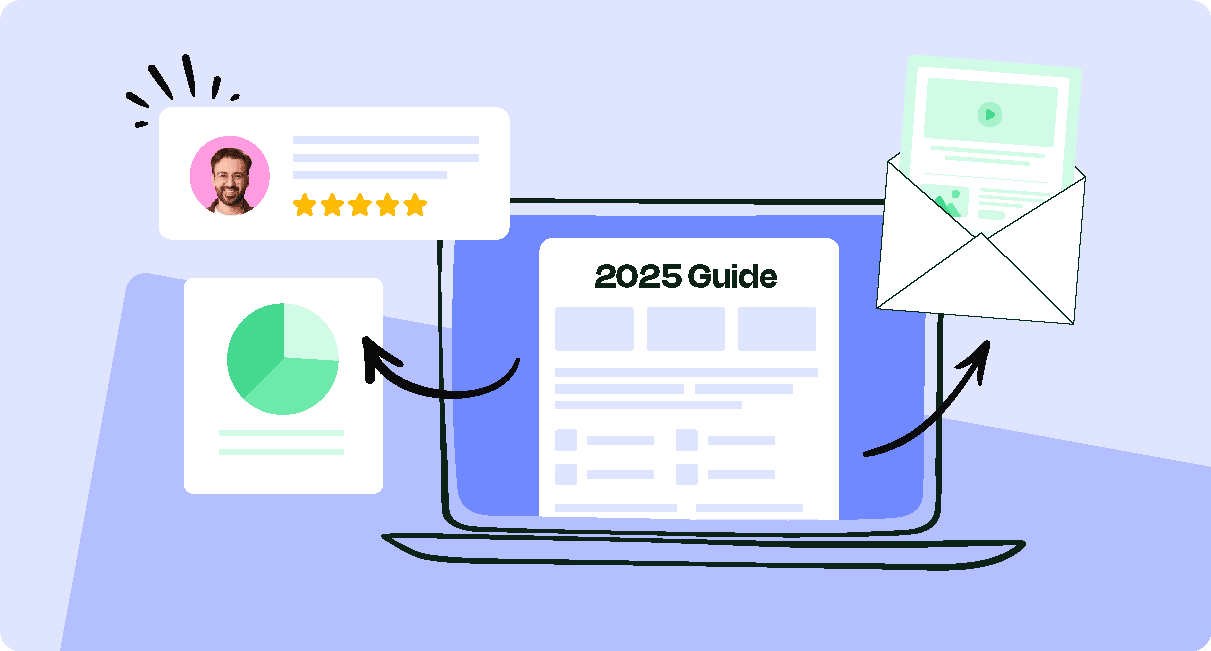If you’ve ever wondered, “Would this comms be better as an email, a Slack message, or a town hall announcement?”, this one’s for you. Consider this your go-to guide for creating an internal communication channel matrix that ensures every message finds the best medium!
In today’s workplace, information flies in every direction—from intranets to instant messaging to email. This makes it a real challenge to keep track of your internal communication channels (and ensure they’re effective).
One solution is to develop an internal comms GPS, otherwise known as an internal communication channel matrix. A channel matrix maps out which types of messages belong where (and when and why). If you’re an internal comms pro or HR leader looking to level up your comms strategy, treat this guide as your roadmap.
In this post, we’ll cover what an internal communication matrix is, its benefits, and a step-by-step process for creating one for your organization.
Take a self-guided tour of ContactMonkey
See how our key features can streamline your internal communications.
Take product tour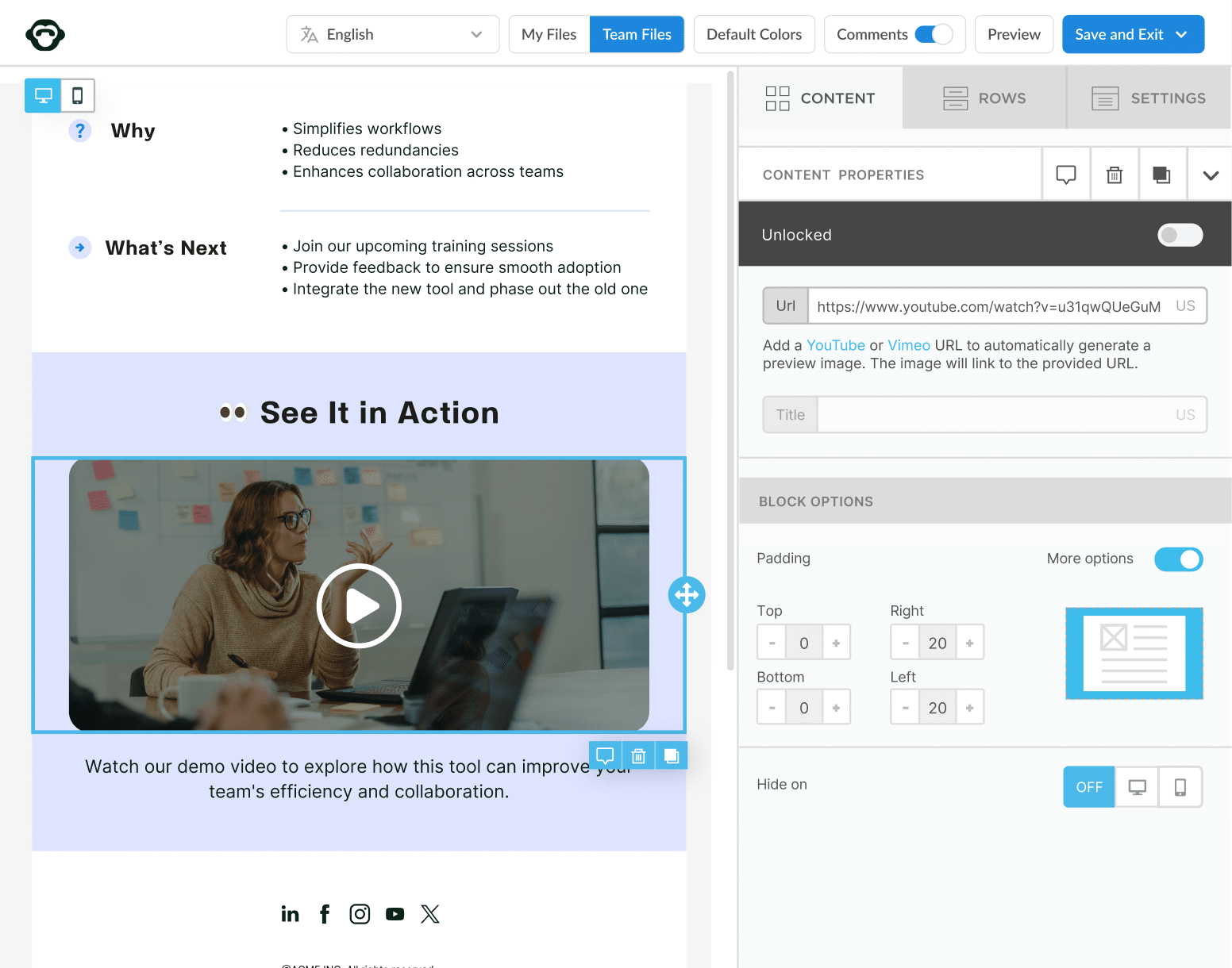
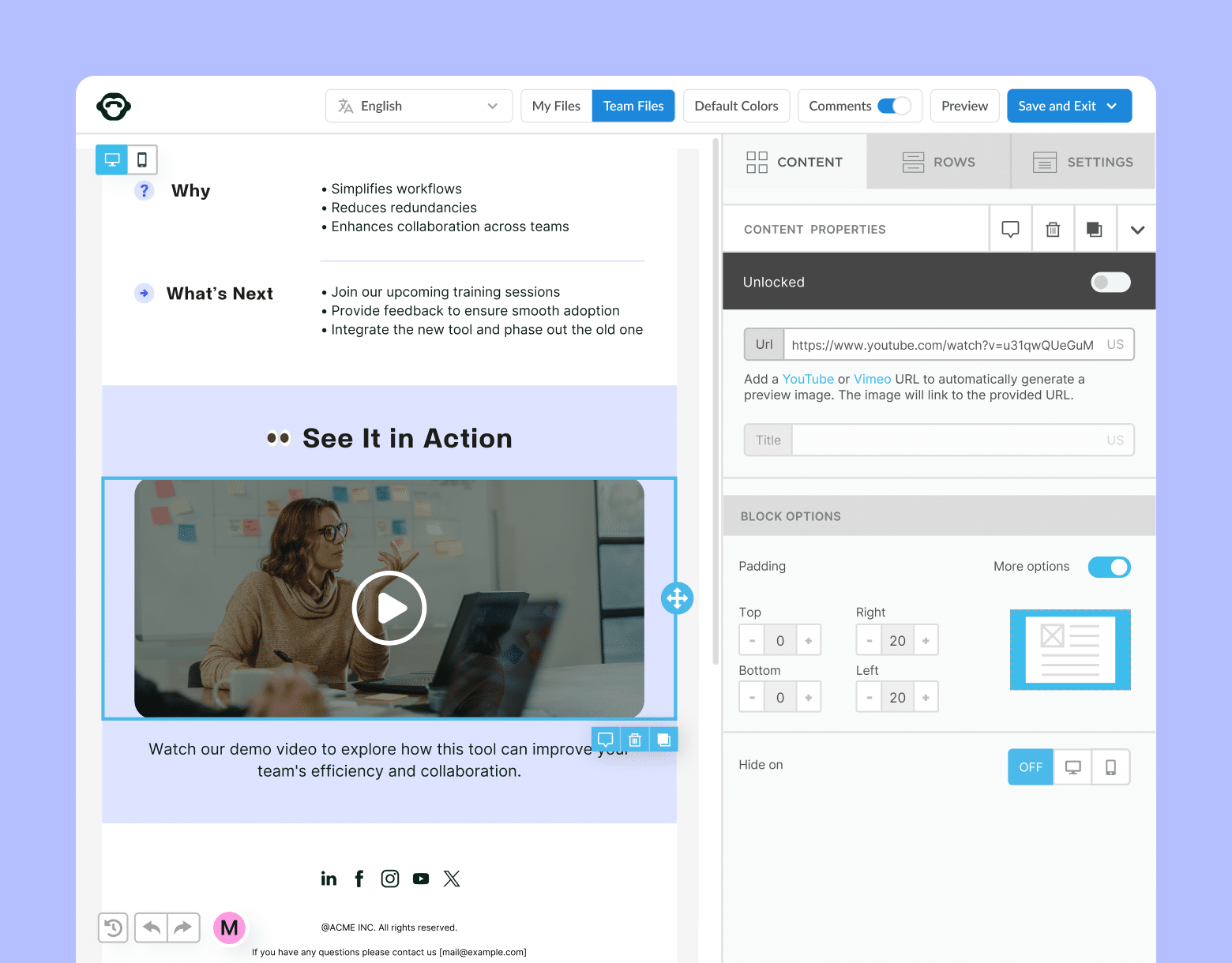
What is an Internal Communication Matrix?
An internal communication channel matrix is a tool that allows communicators to keep their practice strategic and organized. It’s typically a table or spreadsheet that outlines:
- The types of internal communication channels your organization uses
- What each channel is best used for
- Who the target audience is
- How often content should be delivered
- Who owns the content
In other words, it’s the ultimate cheat sheet for ensuring your messages reach the right people, through the right channels, at the right time.
What Are the Benefits of Using an Internal Communication Matrix?
Now you might be thinking, “Cool idea, but do I really need a whole matrix for this?”. The short answer is absolutely. A well-structured internal communication matrix isn’t a pretty spreadsheet—it offers clarity and consistency while aligning key stakeholders.
Here’s what an internal communication channel matrix brings to the table:
- Defined channel purposes: Every channel should earn its keep. A matrix helps you clarify whether a channel is meant to inform, engage, celebrate, or something else entirely.
- Targeted messaging: Different employee groups need different types of information. A matrix helps you tailor message delivery across various internal communication channels to ensure that frontline staff, corporate teams, and remote employees all get what they need.
- Less duplication, more impact: A good matrix prevents the same message from being sent (or worse, ignored) across multiple platforms. No more email fatigue or Slack overload1
- Improved communication flow: When your internal communication channel matrix is well-planned, messages are understood and acted on.
- Channel optimization: When you map your channels, it becomes much easier to identify gaps. You can quickly see what channels are overused, underused, or simply unnecessary.
Modern internal comms and measurement tools
No design or technical expertise needed. Save time, increase engagement, and dazzle your employees with fun and interactive communications.
Explore all features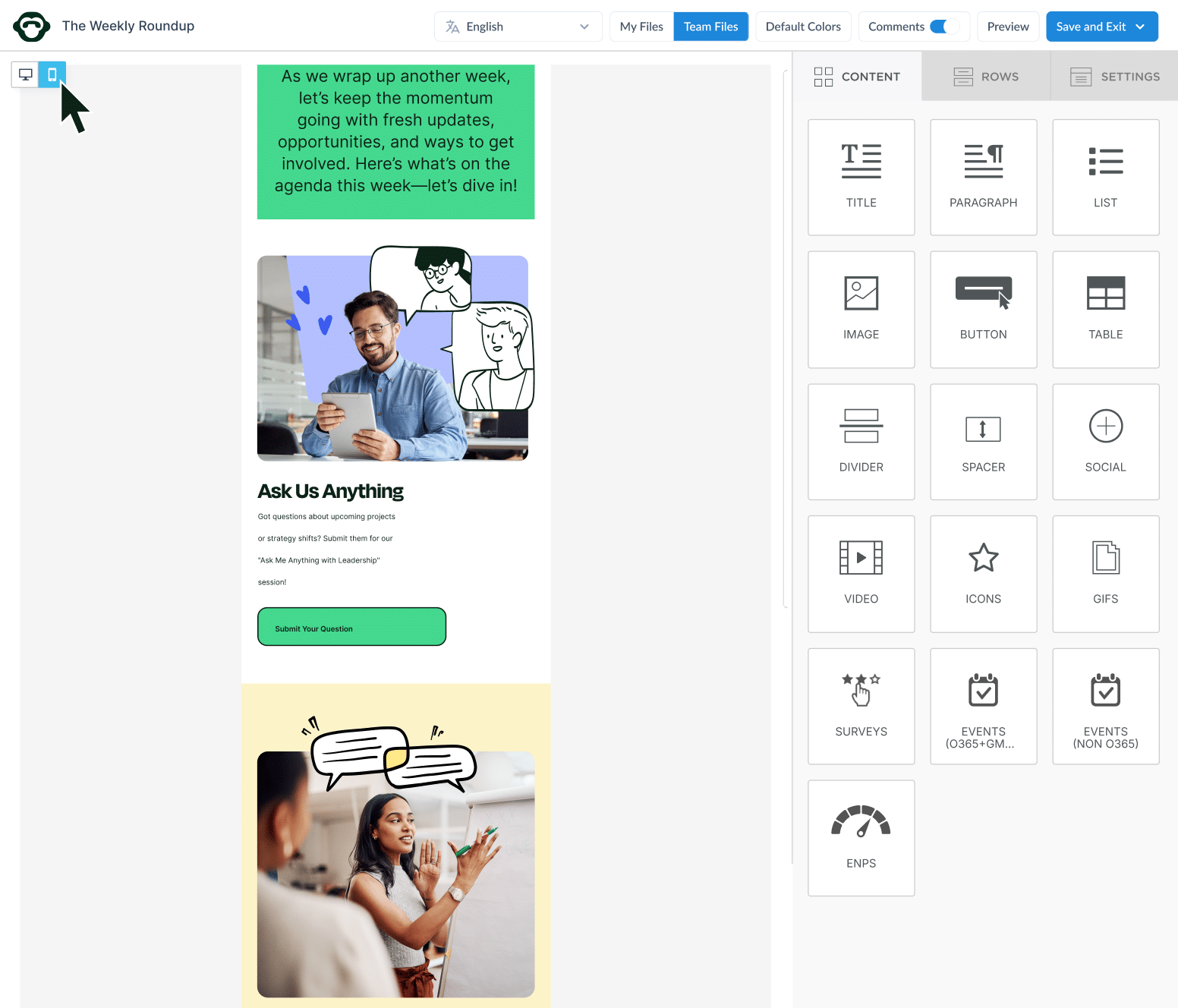
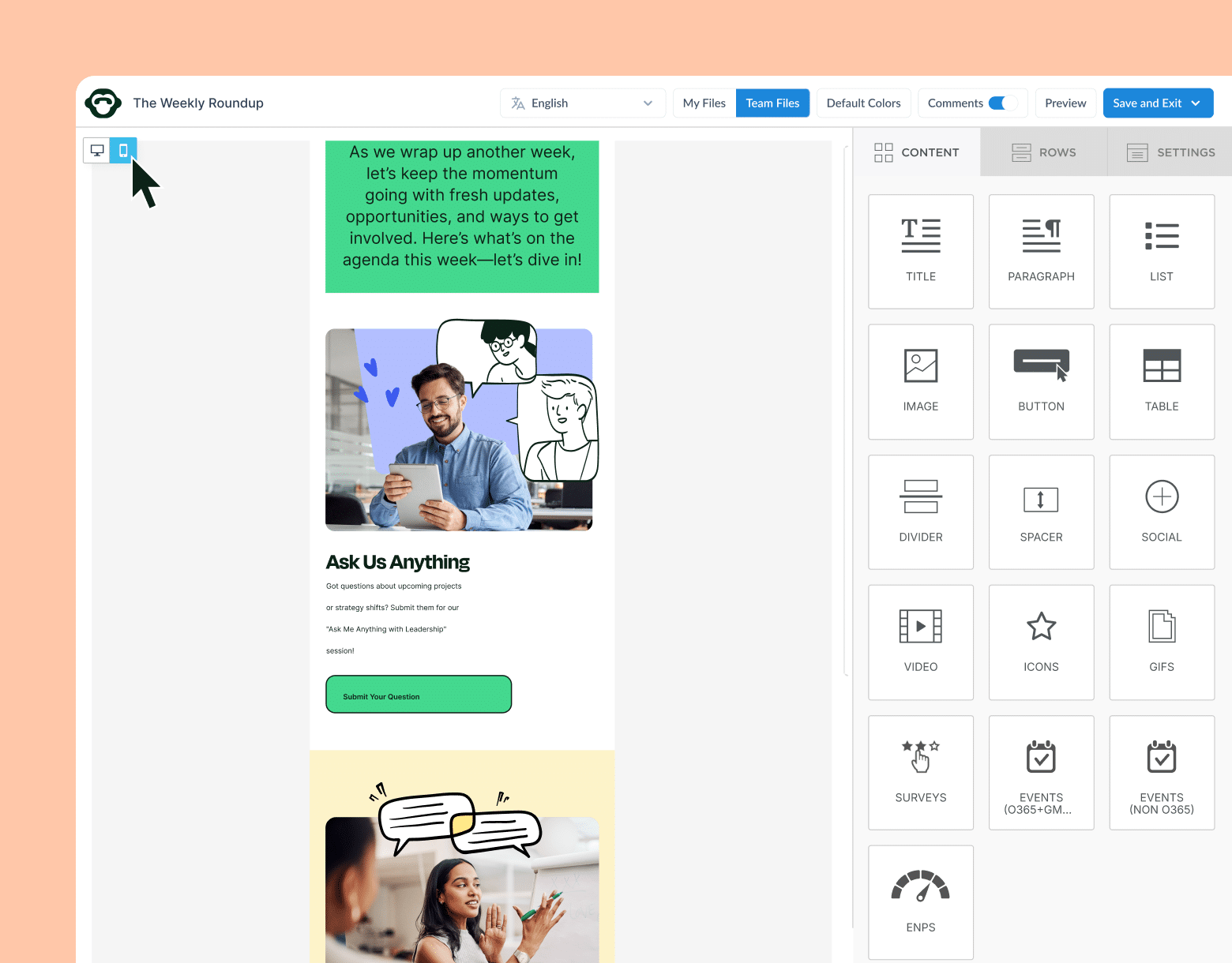
What’s Included in an Internal Communication Matrix?
A strong internal communication matrix doesn’t need to be complicated—but it should be comprehensive. Here’s a quick overview of what your matrix should include:
| WHAT TO INCLUDE | EXAMPLE |
| Channel | E.g. Email, Slack, Intranet |
| Purpose | E.g. Updates, recognition, crisis comms |
| Audience | E.g. All employees, leadership, remote teams |
| Owner | E.g. Who’s responsible for managing content |
| Frequency | E.g. Daily, weekly, monthly |
| Tone | E.g. Formal, casual, engaging |
| Feedback mechanism | E.g. One-way or two-way |
Now, let’s dig into how to build your own internal communication channel matrix template.
6 Steps to Creating Your Internal Communications Matrix
Ready to build a smarter, cleaner, more intentional internal communication strategy? Here’s how to create an internal communication channel matrix that works.
Step 1: Audit your existing internal communication channels
Before you can improve your internal communication, you need to understand your current landscape. An internal communications audit helps you identify which internal communication channels are driving value, which are underperforming, and where gaps exist. It’s your chance to align your channel mix with employee needs and business goals.
What to do:
Create a master list of every internal communication channel in use across your organization. Don’t just think digital—include physical channels like bulletin boards and in-person meetings too. For each one, document:
- Channel name and format (e.g., Email newsletter, Yammer group, Townhall)
- Frequency of use
- Type of content shared
- Target audience
- Content owner or administrator
- Engagement data (if available)
Questions to ask:
- What are we using this channel for?
- Who owns or manages the content?
- Is the intended audience engaging with this channel?
- Is the messaging one-way or two-way?
- Does this channel align with our communication goals?
- Are there overlaps between this and other channels?
- What employee feedback have we received about this channel?
Common pitfalls to avoid:
- Overlooking informal channels: Watercooler chats and unofficial Teams groups can hold a surprising amount of influence. Include them in your audit.
- Focusing only on output, not outcomes: Sending frequent updates doesn’t mean communication is effective. Look at engagement and comprehension, not just volume.
- Ignoring accessibility and inclusivity: Can all employees—especially deskless, remote, or multilingual workers—access and understand the content?
PRO TIP: Use employee engagement analytics (like open rates and click-throughs from tools like ContactMonkey) to assess the effectiveness of your comms.
Unlock Internal Comms Superpowers
Discover why 10,000+ rely on us. See the internal email and employee newsletter platform in action.
Book demo

Step 2: Define each internal communication channel’s purpose
Without a clear purpose, channels become digital dumping grounds—leading to message overload and employee disengagement. This step ensures that each channel in your internal communication channel matrix serves a strategic, defined role in your overall internal communication channel strategy.
What to do:
Assign a specific function or objective to each channel you audited in Step 1. The goal is to define the ideal content and tone for each communication method, helping ensure consistency across all internal communication channels.
Map each channel to one or more communication goals, such as:
- Inform (e.g., company updates)
- Inspire (e.g., leadership vision)
- Instruct (e.g., onboarding)
- Engage (e.g., employee feedback)
- Recognize (e.g., peer shoutouts)
Questions to ask:
- What is the primary purpose of this channel?
- What types of content perform best here?
- Does the tone match the audience and goal?
- Is this channel formal or informal?
- Does this channel support one-way or two-way communication?
Example:
| Channel | Purpose |
| Share key company updates, policies, events | |
| Microsoft Teams | Quick team collaboration and real-time feedback |
| Intranet | Store and access essential documents and resources |
Common pitfalls to avoid:
- Too much overlap: If multiple channels are used for the same purpose, employees may tune out entirely.
- Misaligned tone: Avoid using overly formal language on informal channels like Slack or Teams.
- No room for dialogue: If all channels are one-way, you’re missing out on employee voice and feedback.
BONUS: Keep a glossary to define the purpose of each channel in your internal communication matrix template that outlines how to use each channel consistently. And, know what types of employee content work to drive engagement so you can track content ideas too.
Step 3: Identify the audience segments for your internal comms channel matrix
Employees aren’t one-size-fits-all. Different roles, locations, and levels of digital access require different messaging approaches. Defining audience segments allows you to personalize your communication and ensure relevance—key for an effective internal communication matrix.
What to do:
Categorize your employees into clear segments based on relevant criteria, like:
- Department or function
- Role level (e.g., leadership vs. individual contributor)
- Location (onsite vs. remote vs. hybrid)
- Language preference
- Communication access (e.g., mobile-only, deskless)
Then, match each audience with the most appropriate channels and content formats.
Questions to ask:
- Who needs to receive this message?
- Does this audience have easy access to this channel?
- Are they likely to engage with this type of content?
- Do they prefer short, visual, or detailed formats?
- How do they give and receive feedback?
Common pitfalls to avoid:
- Forgetting frontline or non-desk employees: These groups often get left behind—ensure you have mobile-friendly, accessible channels.
- One-size-fits-all messaging: Personalized comms outperform generic updates every time.
- Over-segmenting: Too many micro-audiences can make your matrix overwhelming and hard to manage.
PRO TIP: Visualize your audience groups directly in your internal communication channel matrix template. For each channel, list the intended audiences and track which segments are underserved. Need more info? Take advantage of these audience segmentation for internal communications examples.
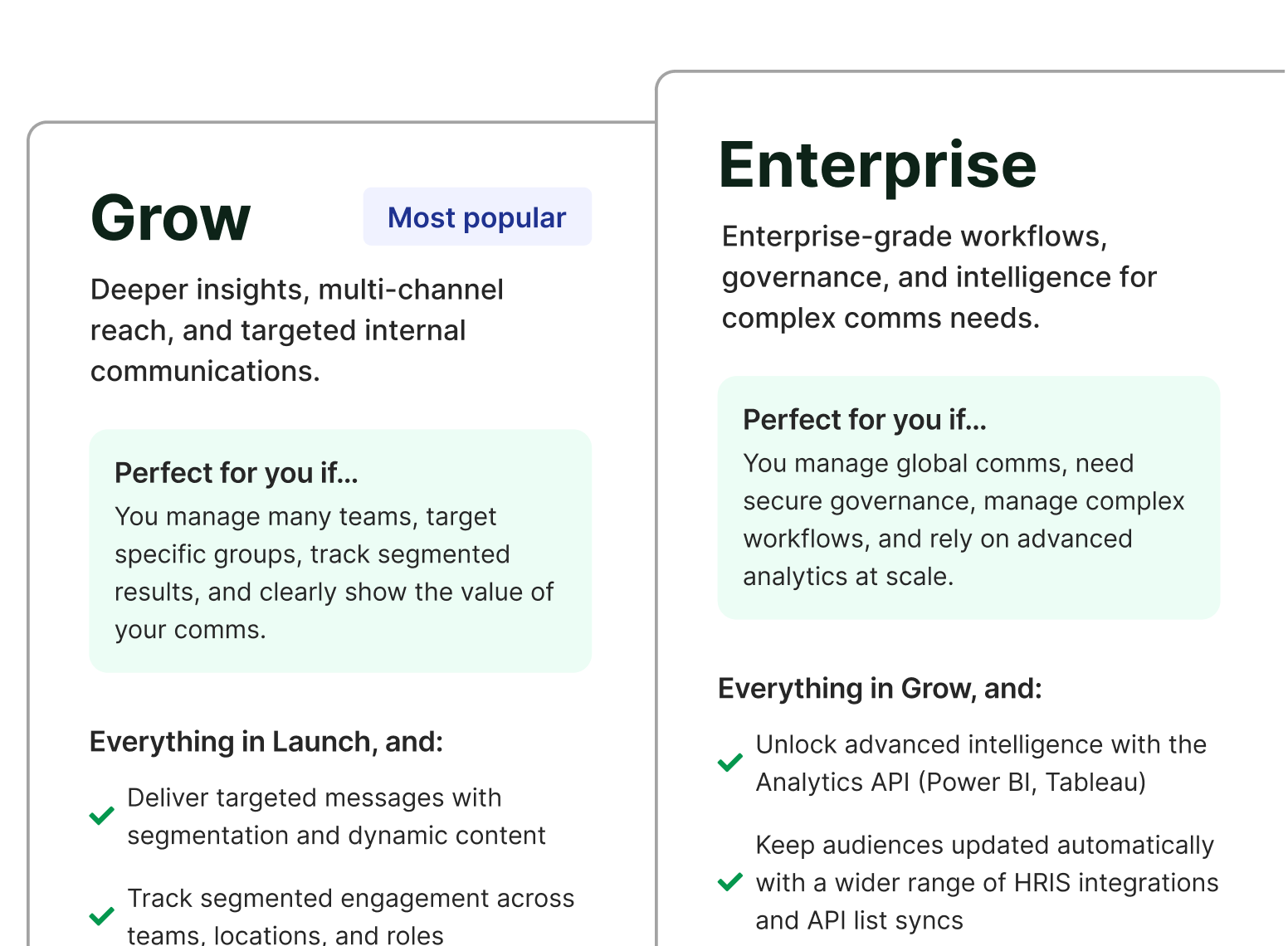
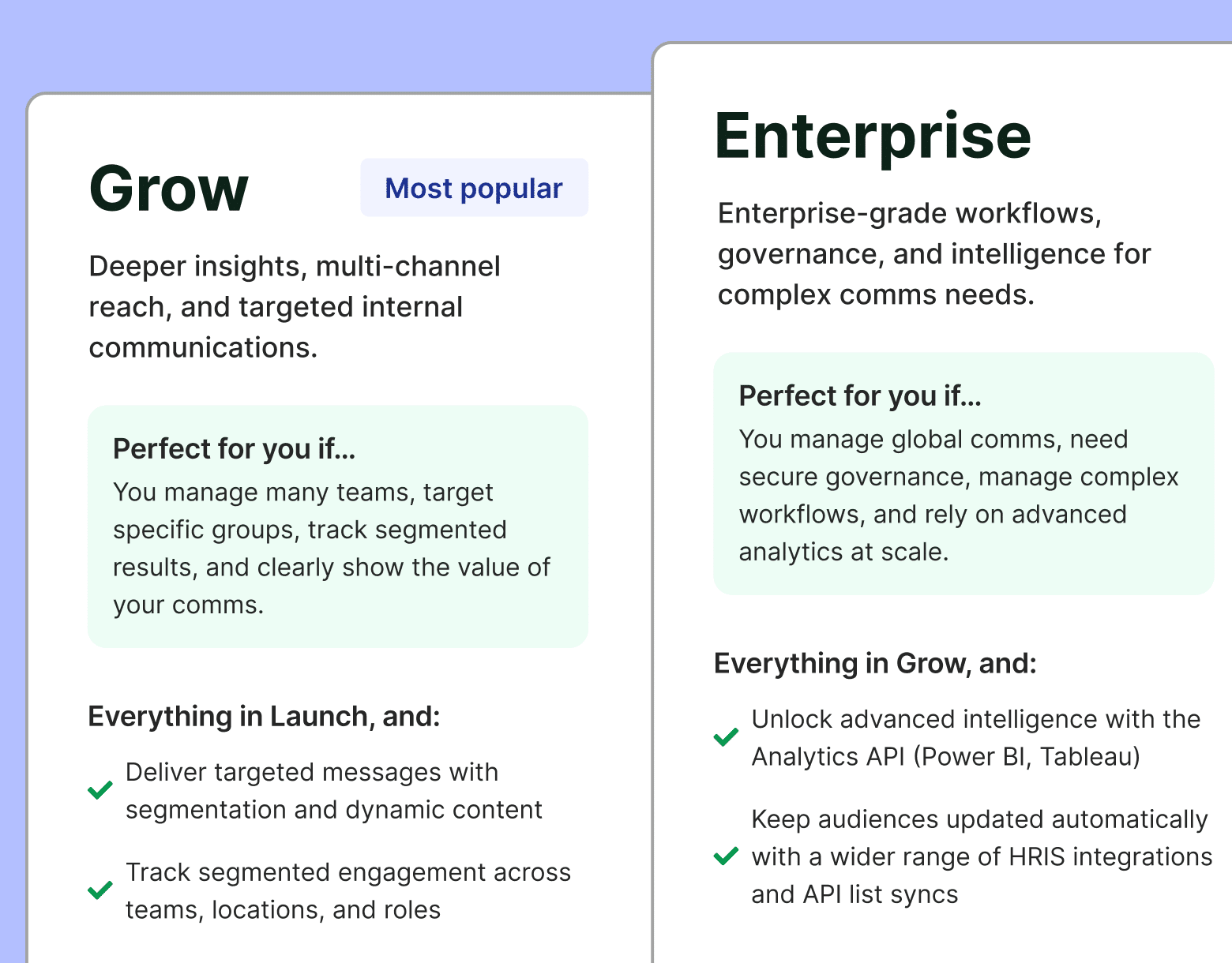
Step 4: Map channels to audiences and content types
This is the heart of your internal communication channel matrix—where your internal communication strategy meets structure. By aligning each channel with its purpose, audience, content type, and cadence, you create a go-to resource for consistent, high-impact communication.
What to do:
Build out a comprehensive internal communication matrix (use a spreadsheet or visual table). Include the following columns:
- Channel name
- Purpose
- Primary audience
- Content type
- Frequency (how often you use it)
- Owner (who manages it)
- Communication direction (one-way or two-way)
- Measurement (how you track effectiveness)
Questions to ask:
- Are we using the right mix of channels for this audience?
- Is each communication type delivered through the most effective channel?
- Are ownership and accountability clearly defined?
- Is feedback possible where appropriate?
Common pitfalls to avoid:
- Missing ownership: Without clear responsibility, channels fall into disuse or misuse.
- Underestimating cadence: Over-communicating is just as risky as under-communicating.
- Neglecting analytics: If you’re not measuring it, you can’t manage it.
Step 5: Evaluate the balance of your internal communications channel matrix
A strong internal communication channel matrix is balanced, not bloated. You want a healthy mix of one-way and two-way communication, synchronous and asynchronous channels, and messages that resonate rather than repeat.
What to do:
Once your internal communication channel matrix is complete, take a step back and look at the bigger picture. This is your opportunity to identify patterns, spot imbalances, and uncover areas for improvement. Pay attention to:
- Channels that may be overused causing information fatigue
- Channels that are underutilized our outdated
- The amount of formal and informal communication methods (note: you’re looking for a healthy blend here)
- Whether your strategy encourages employee feedback
Questions to ask:
- Do we rely too heavily on email or meetings?
- Are employees overwhelmed by too many messages?
- Do all teams have a voice in the communication flow?
- What’s missing? Do we need to introduce new channels or retire old ones?
Common pitfalls to avoid:
- Too many channels for the same message: This leads to fatigue and confusion.
- No feedback mechanisms: Employees want to feel heard—build in channels for two-way conversation.
- Neglecting asynchronous options: Not everyone can attend a live meeting. Make recordings or recaps available.
PRO TIP: In ContactMonkey, use engagement or pulse surveys in ContactMonkey to get direct input from employees about their communication preferences and challenges. Plus, these employee feedback examples will help you get clear on what kind of feedback you can leverage and how to address the different feedback.
Get powerful email analytics and reporting features
Know exactly who is opening and engaging with your employee communications and company newsletters.
Explore analytics & reporting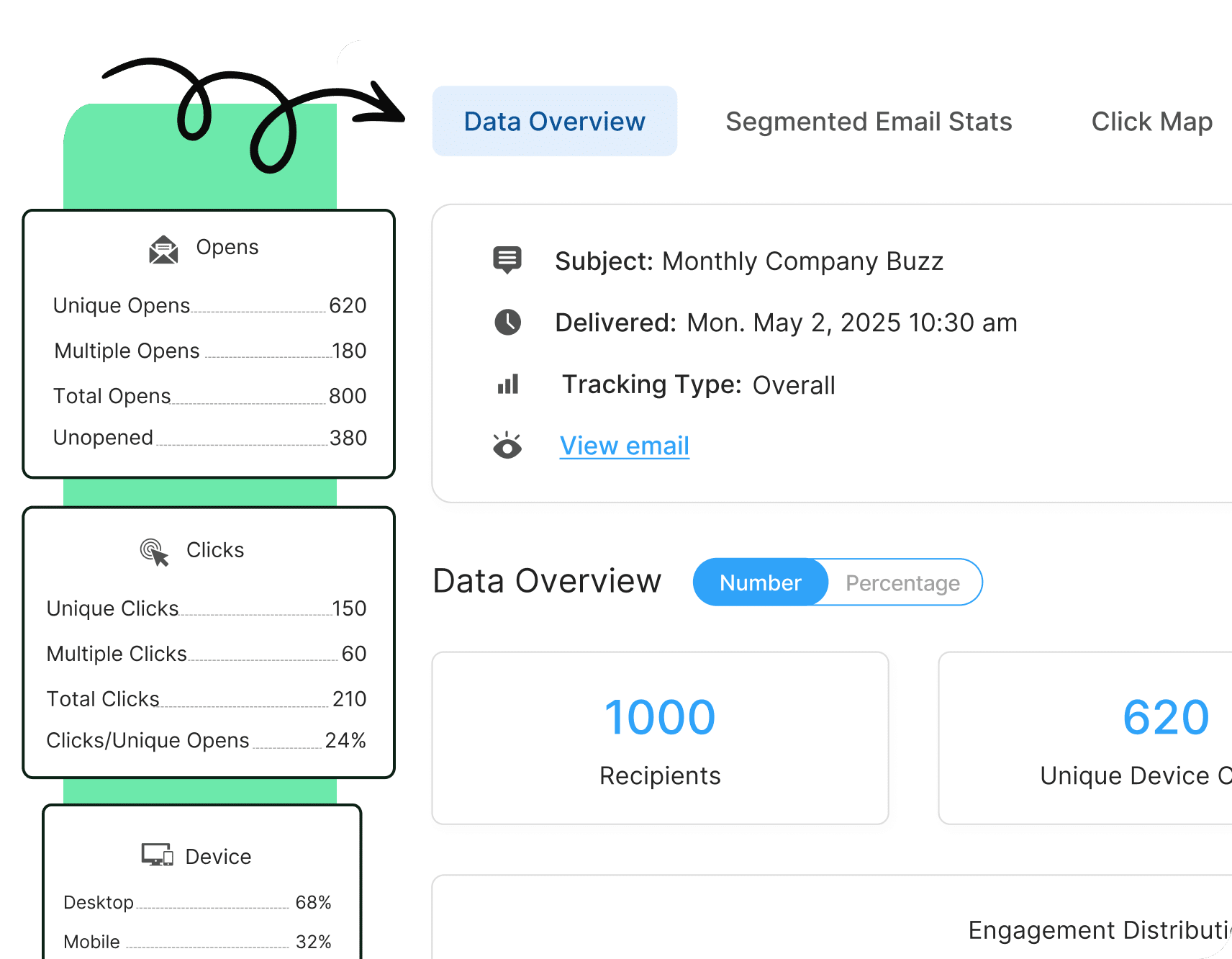
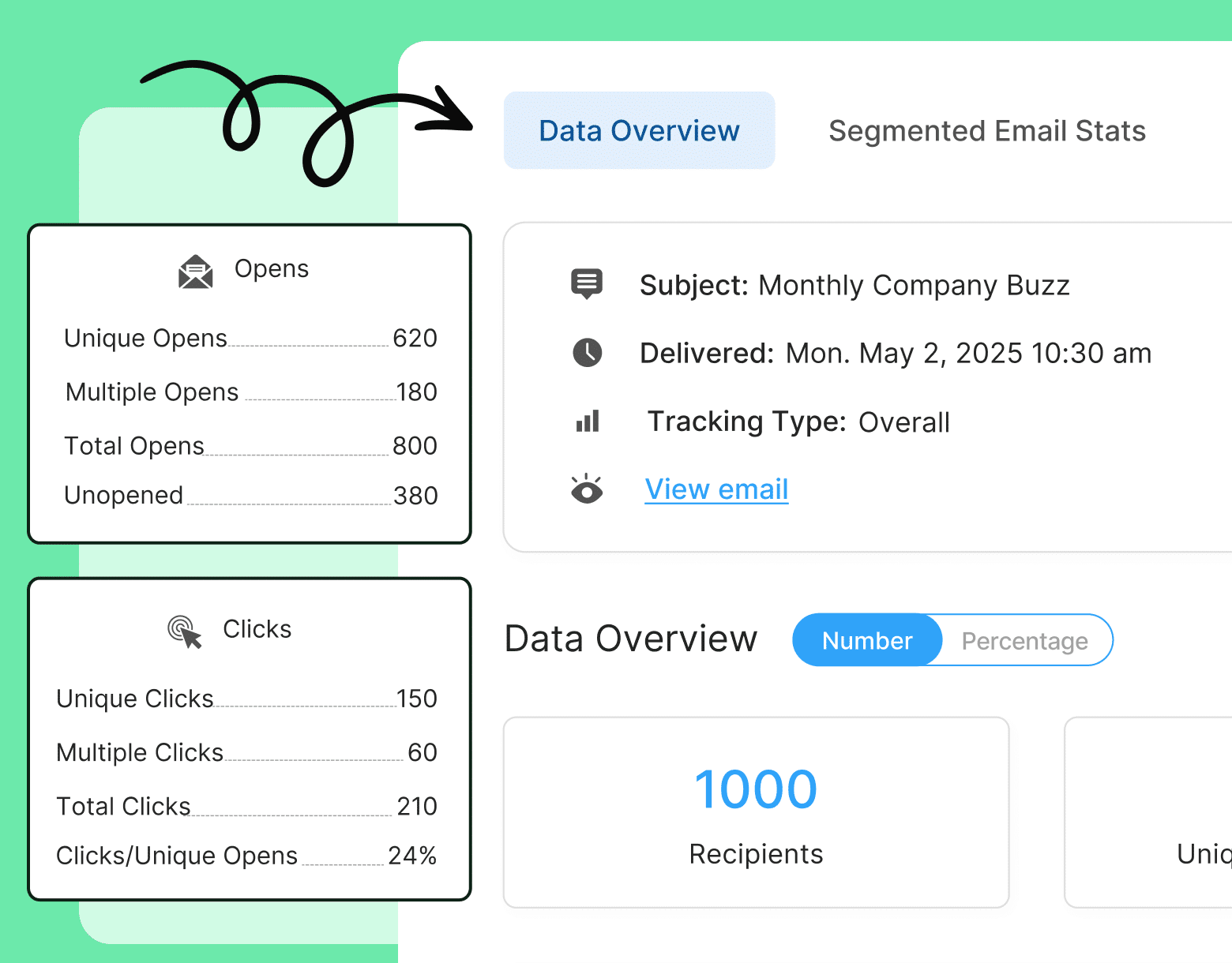
Step 6: Optimize, retire, and refresh
Your internal communication matrix isn’t a “set it and forget it” tool. Organizations change. Employee expectations evolve. Channels rise (and fall). Regular optimization ensures your communication remains relevant, efficient, and engaging.
What to do:
Set a review cadence (quarterly or bi-annually) and look at the following:
- Evaluate engagement and performance data
- Gather employee feedback
- Identify underperforming or duplicative channels
- Add or retire channels as needed
- Update audience preferences and tech tools
Questions to ask:
- Which channels need to be refreshed or retired?
- Are new tools or platforms worth exploring?
- What’s changed in our workforce or company structure?
- Are we meeting accessibility and DEI standards?
- Are our metrics improving over time?
Common pitfalls to avoid:
- Letting the matrix go stale: A dusty document helps no one. Schedule regular reviews.
- Failing to align with IT or leadership: Make sure any new tools or changes are supported and budgeted for.
- Overcomplicating the refresh process: Simple, small changes over time often yield the best results.
BONUS: If email is still your organization’s most valuable channel, use this guide on implementing an internal email strategy to inform your internal communication channel matrix template.
ContactMonkey’s Role in Your Internal Communication Channel Matrix
ContactMonkey helps internal comms pros improve the clarity, consistency, and measurability of their internal communication matrix, especially when using email as a core channel.
Here’s how it fits into your matrix:
- Assigns purpose to email: Design and send internal emails with clear goals—announcements, updates, surveys, onboarding, and more—directly from Outlook or Gmail thanks to integration features.
- Supports audience segmentation: With our list management feature, send personalized content by department, role, or location to ensure the right people get the right message.
- Tracks engagement: The analytics dashboard feature provides real-time analytics (opens, clicks, read time, survey results) to evaluate email performance across audiences and regions.
- Enables two-way communication: Embed interactive elements like pulse surveys, emoji reactions, and comments to capture employee voice – thanks to employee feedback features.
- Informs channel strategy: Use performance insights to update your internal communication channel matrix and identify what’s working—and what’s not.
With ContactMonkey, email becomes a more powerful tool within your internal communication channel strategy. Ready to take your internal communication channel strategy to the next level with better comms? Book a demo, today and see for yourself!

